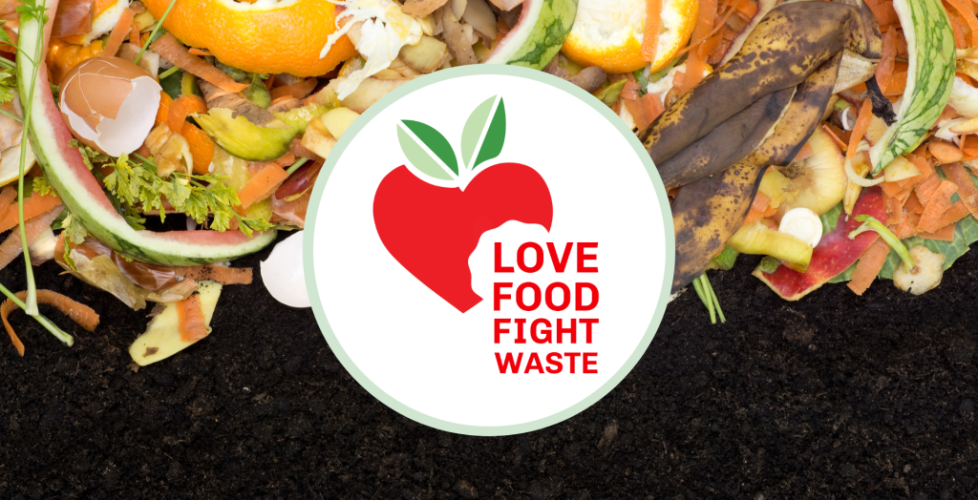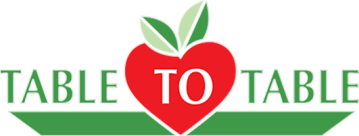Deep dive into composting
Banana peels, watermelon rinds, corncobs, eggshells, coffee grounds – the list goes on of food scraps that we don’t traditionally eat. Once we’ve eaten the banana, scrambled the eggs, and drank the coffee, what can we do with these non-edible scraps? Compost them!
Monthly Topic Overview
The Love Food, Fight Waste program has focused mainly on food waste reduction over the last several months because preventing food waste from forming in the first place is the top priority for reducing our environmental footprints. This priority is concerned with edible foods – the banana, not the peel; the egg, not the shell. For these non-edible food parts, composting is a great alternative to throwing these items out.
Below are several common questions related to composting answered.
What is composting?
Composting is the process of turning organic material (food scraps, garden/yard waste) into a nutrient-rich material that can be added to lawns and gardens to improve the health of the soil and the plants that grow in it.
Decomposition, the breakdown of materials, happens naturally in the environment. For example, leaves fall off trees during autumn and slowly decompose into detritus (organic matter) with the help of bacteria and bugs.
Composting is “facilitated decomposition.” The organic material in a compost pile is still naturally breaking down with the help of bacteria and bugs. In addition to this natural breakdown, Compost Operators facilitate this process by turning the pile to let oxygen in. Oxygen is needed for the materials to decompose.
What is organic material?
Organic material includes the following:
- Food (including fruits, vegetables, grains, meat, dairy)
- Garden/yard waste (including branches, grass, leaves, flowers, plants)
- Paper (including shredded paper, greasy/cheesy pizza boxes, paper napkins, paper towels)
- Clean paper, such as a pizza box with no food on it, is also fine to recycle.
- Shredded paper, due to its small size, is difficult to successfully sort at our recycling sorting facility in the mix of other materials which is why we do not accept shredded paper in curbside recycling. Shredded paper can be composted, or it can be recycled via the paper bin at a local recycling drop-off location.
What can be composted at our local Compost Facility?
All of the materials listed above in the last question: food, garden/yard waste, and paper products!
Who can compost at our local Compost Facility?
The Iowa City Landfill and Recycling Center, where the Compost Facility is located, serves all of Johnson County (residents at no cost, and businesses for a fee).
Where is our local Compost Facility?
The Compost Facility is located at the Iowa City Landfill and Recycling Center on the west side of town, 3900 Hebl Ave. SW, Iowa City. The facility is open Monday to Saturday from 7 a.m. to 4:30 p.m.
How does our local Compost Facility make compost?
From start to finish, the composting process takes about one year at our facility. Here’s how it works:
As clean loads of organic material come into the compost facility at the landfill, it is piled in a designated area. Our Compost Operators use equipment to lift material from the pile and load it into the grinder equipment. The grinder shreds the organic material into evenly sized pieces. This shredded material is then formed into long rows that are approximately 12 feet high.
The organic material in a compost pile is naturally breaking down over time with the help of bacteria and bugs. In addition to this natural breakdown, Compost Operators facilitate this process by turning the material with equipment once per month. As the bugs and bacteria are working away breaking material down, they produce heat, water vapor, and carbon dioxide. Turning and mixing the material is an important step because it allows oxygen in and releases heat which maintains a healthy temperature and oxygen level.
During the processing time, each compost row is required to maintain a temperature of at least 132 degrees F for a consistent two-week period. This requirement ensures that heat kills harmful bacteria and pathogens.
After several months of decomposition, monthly turning, and consistent monitoring, the material processes into the nutrient-rich soil amendment that we call compost. Before it is available to the public for sale, the compost is fed through the screener equipment to pull out any large organic pieces that did not properly break down or contamination pieces. It sits for one month to return to ambient temperature, and then it is available for sale to residents and businesses in Johnson County.
How can I compost at home?
- Curbside composting
- Curbside composting is available to Iowa City residents living in single-family homes up to 4-unit apartment buildings ($3.50/month on utility bill).
- If you are a curbside customer, check out the composting website.
- Backyard composting
- Learn how to compost in your backyard with these composting resources.
- Take materials to the Compost Facility
- If you would like to reduce trips and wait until you have a larger quantity of food waste, place in the freezer until you are ready to compost to avoid odor and rot issues.
Don’t forget about source reduction!
Composting is a food waste disposal method that is environmentally-better than landfilling, but it is still waste. It is important to eat edible food as the first priority to prevent wasting good food and to reserve composting for the non-edible food parts.
Activity
If you compost:
Look in your compost bin to see the different items that have been thrown in. Are the food items non-edible, like coffee grounds, or are they food items that could have been eaten and instead were wasted, like moldy bread?
If you don’t compost:
Look in your trash can to see what has been thrown away. Do you see any non-edible food waste that could be composted? Check out the tips above to learn how you can get started with composting.
Resources
- Residential Curbside Composting Information:
- Home Composting Resources
- Learn more about the Iowa City Landfill services and the Compost Facility with this short video.
- NPR’s 5-step guide to composting
- Beginner’s guide to composting: How do I compost? Where does it end up? How does it help fight climate change?
Read more Love Food, Fight Waste topics, brought to you by Table to Table and the City of Iowa City.


